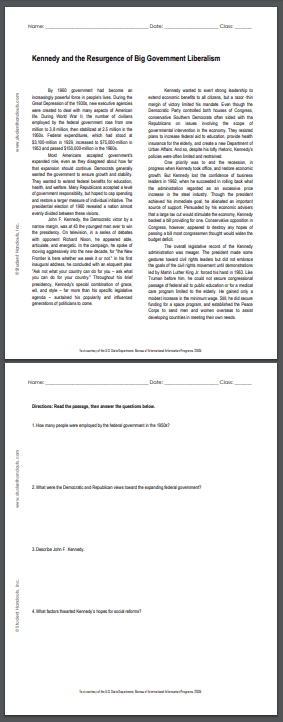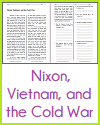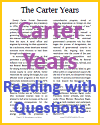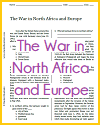| Kennedy and the Resurgence of Big Government Liberalism Reading with Questions |
|---|
| www.studenthandouts.com ↣ American History ↣ American History Readings with Questions |
By 1960 government had become an increasingly powerful force in people's lives. During the Great Depression of the 1930s, new executive agencies were created to deal with many aspects of American life. During World War II, the number of civilians employed by the federal government rose from one million to 3.8 million, then stabilized at 2.5 million in the 1950s. Federal expenditures, which had stood at $3,100-million in 1929, increased to $75,000-million in 1953 and passed $150,000-million in the 1960s. Most Americans accepted government's expanded role, even as they disagreed about how far that expansion should continue. Democrats generally wanted the government to ensure growth and stability. They wanted to extend federal benefits for education, health, and welfare. Many Republicans accepted a level of government responsibility, but hoped to cap spending and restore a larger measure of individual initiative. The presidential election of 1960 revealed a nation almost evenly divided between these visions.
Most Americans accepted government's expanded role, even as they disagreed about how far that expansion should continue. Democrats generally wanted the government to ensure growth and stability. They wanted to extend federal benefits for education, health, and welfare. Many Republicans accepted a level of government responsibility, but hoped to cap spending and restore a larger measure of individual initiative. The presidential election of 1960 revealed a nation almost evenly divided between these visions.John F. Kennedy, the Democratic victor by a narrow margin, was at 43 the youngest man ever to win the presidency. On television, in a series of debates with opponent Richard Nixon, he appeared able, articulate, and energetic. In the campaign, he spoke of moving aggressively into the new decade, for "the New Frontier is here whether we seek it or not." In his first inaugural address, he concluded with an eloquent plea: "Ask not what your country can do for you—ask what you can do for your country." Throughout his brief presidency, Kennedy's special combination of grace, wit, and style—far more than his specific legislative agenda—sustained his popularity and influenced generations of politicians to come. Kennedy wanted to exert strong leadership to extend economic benefits to all citizens, but a razor-thin margin of victory limited his mandate. Even though the Democratic Party controlled both houses of Congress, conservative Southern Democrats often sided with the Republicans on issues involving the scope of governmental intervention in the economy. They resisted plans to increase federal aid to education, provide health insurance for the elderly, and create a new Department of Urban Affairs. And so, despite his lofty rhetoric, Kennedy's policies were often limited and restrained. One priority was to end the recession, in progress when Kennedy took office, and restore economic growth. But Kennedy lost the confidence of business leaders in 1962, when he succeeded in rolling back what the administration regarded as an excessive price increase in the steel industry. Though the president achieved his immediate goal, he alienated an important source of support. Persuaded by his economic advisers that a large tax cut would stimulate the economy, Kennedy backed a bill providing for one. Conservative opposition in Congress, however, appeared to destroy any hopes of passing a bill most congressmen thought would widen the budget deficit. The overall legislative record of the Kennedy administration was meager. The president made some gestures toward civil rights leaders but did not embrace the goals of the civil rights movement until demonstrations led by Martin Luther King Jr. forced his hand in 1963. Like Truman before him, he could not secure congressional passage of federal aid to public education or for a medical care program limited to the elderly. He gained only a modest increase in the minimum wage. Still, he did secure funding for a space program, and established the Peace Corps to send men and women overseas to assist developing countries in meeting their own needs. Directions: Read the text above, then answer the questions below. 1. How many people were employed by the federal government in the 1950s? 2. What were the Democratic and Republican views toward the expanding federal government? 3. Describe John F. Kennedy. 4. What factors thwarted Kennedy's hopes for social reforms? Click here to print. |
 |  |  |  |  |  |
| www.studenthandouts.com ↣ American History ↣ American History Readings with Questions |








